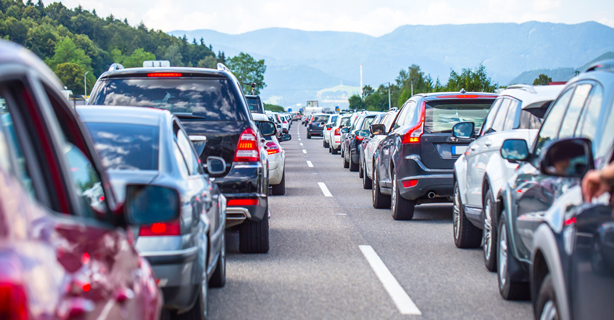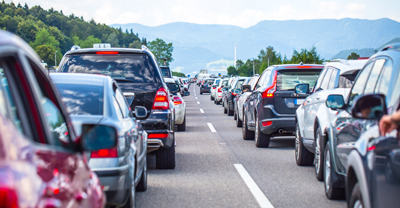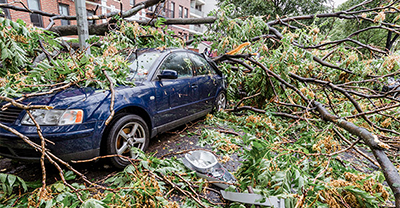Why are car insurance rates increasing?


0 min. read
Across the United States, the cost of car insurance is up 19% from autumn 2022 to autumn 2023.* That's the most significant annual increase since 1976. With these increases outpacing overall inflation, drivers are wondering, “Why is this happening?”
What's led to car insurance rate increases?
Several major factors are driving this rapid increase:
General inflation has hit many sectors of the economy
Supply chain issues have led to higher car repair costs
Post-pandemic driving has gotten riskier
Climate change is contributing to an increasing number of extreme weather events
Reinsurance rates for insurance companies have risen
Understanding what's behind these rising rates can help you know what to expect in the future. It may also help you determine which types of auto coverages are worth keeping or dropping as budgets get tighter.
General inflation is driving up prices
The first force behind increasing car insurance rates is the general rise in global inflation. Inflation refers to prices rising across the board for goods and services over time. When inflation goes up, the cost of doing business for companies rises too.
In 2022, the U.S. inflation rate hit a 40-year high,* driving up business costs in every industry, including car insurance. From the cost of car parts and repair labor to medical bills and liability claims, inflation has made everything tied to auto insurance pricier.
Why does inflation lead to increased car insurance costs?
To understand how inflation impacts car insurance prices, it helps to break down key areas where rates are increasing for insurers:
Repair costs: As of July 2023, auto repair costs had risen by more than 20% year over year. Components from computer chips to catalytic converters are in short supply. At the same time, garages and body shops face rising rents. These repair cost spikes get directly passed to customers in rate hikes. You can help mitigate this by DIYing some of your repairs.
Medical bills: Accident-related procedures covered by bodily injury liability and medical payments or personal injury protection (PIP) have become more expensive, with hospital staff shortages and record rate increases for ambulance rides. As a result, claim payments for accident victims can quickly get very expensive for insurers.
Accident claims: With used car prices up 40%* compared to pre-pandemic levels, replacing total loss vehicles after wrecks brings epic payouts, erasing insurer margins. Rental coverage rates have also increased, as delayed parts keep customers in rental cars for months in some cases.
This all means that while the coverage you get under your policy hasn't changed, dramatic inflation means all those promised repairs, medical payments, and accident claims cost your insurance provider more.
Supply chain issues causing repair delays and higher costs
Another fallout from the pandemic that translates to pricier auto insurance premiums? Widespread supply chain disruptions have led to growing repair delays and costs. Similar to extreme general inflation, the depth of supply chain woes directly impacts how much extra insurance companies pay out on auto accident claims. Some major factors amplifying insurer costs include:
Replacement parts shortages: Safety components like airbags and seatbelts see massive backorders, as do electronic control modules that run all car computers. Some insurers now report year-plus waits on many repairs.
Increased storage fees: Long repair delays mean insured wrecks sit at tow lots and body shop properties, racking up daily storage charges and adding thousands in extra costs.
Diminished drivable cars: As cars wait weeks or months for parts, fewer damaged vehicles get fixed quickly enough to remain drivable under policy provisions. This puts more drivers into rentals and more cars in storage, simultaneously straining insurer finances.
Escalating total losses: Modern cars stuffed with electronics and missing components often get declared total losses within weeks when repair parts remain scarce.
Rising substitute part prices: Even aftermarket versions of scarce parts made by third parties have shot up in price. This leads to long waits as desperate shops overpay component brokers, driving up insurer claim costs exponentially.
Post-pandemic driving habits are riskier
During the COVID-19 pandemic lockdowns, premiums fell as cars stayed parked for extended periods. However, once drivers returned to the roads, many poor driving habits did as well. Auto insurance executives report that these risky habits have persisted even as traffic levels resumed. Data shows the number of fatal accidents spiked in late 2020 and early 2021.
While crash rates have moderated somewhat, they remain elevated compared to pre-pandemic baselines—further fueling premium increases.

Get a free quote for affordable auto insurance.
Climate change is contributing to extreme weather damage
Devastating storms powered by climate change also take a toll on car insurance rates across huge regions. As temperatures and sea levels rise, extreme weather events like destructive hurricanes, flooding rainstorms, aggressive wildfires, and hailstorms often intensify. The growing frequency and severity of these disasters can lead to insurance premium increases in vulnerable areas.
Catastrophic storms that damage property on a massive scale have become eerily routine. And all that property damage means staggering claims costs for insurance companies. For example, Hurricane Ian wracked Florida in 2022, with over $47 billion in projected insured losses, according to analytics firm CoreLogic.
Even a single town getting pummeled takes a toll on insurance finances. A giant hailstorm that hit Calgary, Canada, in 2020 caused an estimated $1.2 billion (CAD) in insured auto and property damage. Such epic events create a ripple effect of spiking premiums across surrounding regions to help insurers recoup catastrophic costs.
While climate change negatively impacts society in many ways, car insurance stands out as taking an immediate hit. States prone to hurricanes, flooding, hailstorms, and wildfires have shouldered up to 10% increases in premiums as disaster-related claims overwhelm insurance providers. With no slowdown in extreme weather projected anytime soon, climate change could keep upward pressure on rates indefinitely.
Extreme weather perils and their impact on rates
It's tempting to lump severe weather and other natural disasters together when examining climate change’s impacts on insurance rates, but the nuances of certain extreme weather perils affect car insurance prices in unique ways.

The costliest climate events cause a spike in total losses from flooding ruin along with escalated health claims from accident-related injuries. Premiums often jump 10–20% after a major hurricane strikes across entire regions

While less costly overall than hurricane devastation, highly localized hail and wind still cause amplified damages that can lead to comprehensive claims—from shattered windows, dents, fallen limbs, flying debris, and more.

In fire-prone states, escalating wildfire destruction can lead to vehicle damage tied to falling trees and debris from adjacent burn zones, even well away from the deadliest infernos.

Surging rainfall events flood out thousands of vehicles in low-lying zones each year.
Reinsurance rates have increased
Finally, an overlooked yet critical player in rising car insurance costs: reinsurance rates that protect carriers from insolvency.
Reinsurance refers to "insurance for insurers," where large national or global pools assume some risks from insurance companies. This backup coverage keeps insurers solvent if massive claims from extreme weather events like hurricanes or supply chain snags threaten their finances.
However, reinsurers have paid out significant amounts in recent disaster claims, eating into their own bottom lines. Like standard insurers, this has caused many reinsurance firms to raise rates to restore healthy profits.
Reinsurance rates can increase due to a range of different factors, including:
Catastrophe claims outlays: Strong hurricanes and complex statewide fires and floods cause reinsurers to shell out billions in extraordinary event payments to keep struggling insurers solvent.
Reduced profit margins: Huge unpredictable payouts drop many reinsurers' annual profits significantly across both the auto sector and property/casualty portfolios.
Across-the-board premium hikes: Cushioning thinner profits and ratings hits, global reinsurance giants raise the premiums they charge insurance providers.
When reinsurance rates rise, that financial burden trickles down to consumers through higher monthly premiums. Essentially, insurers pass some portion of ballooning catastrophe reinsurance costs to policyholders to stabilize the industry.
How to manage increasing auto insurance rates
Consider increasing your deductible to potentially reduce your monthly payments.
Drop optional coverages like rental reimbursement if money is tight. Eliminating less essential add-ons lets you prioritize core liability and collision.
Compare rates annually, as some insurers spread hikes unevenly. Shop around for the best deals every renewal season.
Ask your insurance provider about discounts you could qualify for, such as:
Multi-car
Anti-theft devices
Payment frequency
Homeowners
Defensive driver course
Get a Dairyland® auto insurance quote
As you manage the ongoing impacts of rising car insurance costs, reliable carriers like Dairyland—a brand of the Sentry Insurance Group—help by simplifying comparisons. We provide fast, customized quotes using easy online tools.
The general information in this blog is for informational or entertainment purposes only. View our blog disclaimer.
*Data accuracy is subject to this article's publication date.










